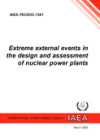International Conference on Resilience of Nuclear Installations against External Events from a Safety Perspective - Focus on Climate Change
20–24 October 2025, Vienna, Austria
Resilience of Nuclear Installations Against External Events: Focus on Climate Change
Purpose and Objectives
This conference provides a platform to share developments and lessons learned regarding the safety and resilience of nuclear installations with respect to external events such as floods, high winds, and earthquakes. Climate change can affect the frequency and severity of some natural hazards, so the conference will have a special focus on climate change impacts on installation safety. Furthermore, changes in land use, aircraft flight patterns, and addition of nearby industrial facilities can also increase design basis hazards or give rise to new external events not previously considered. Discussions and collaborations such as this conference are one way the Agency promotes the exchange of information to enhance nuclear safety. This can benefit all Member States in designing, licensing, operating, and decommissioning their nuclear installations. Additional details can be found in the Announcement and Call for Papers.






